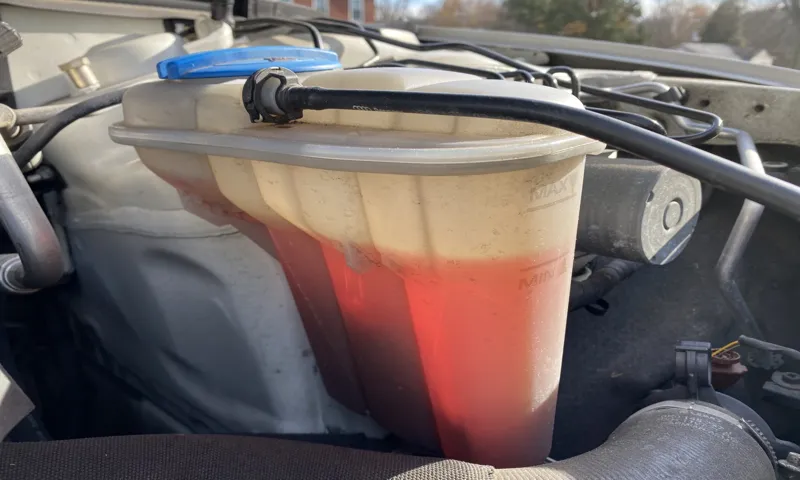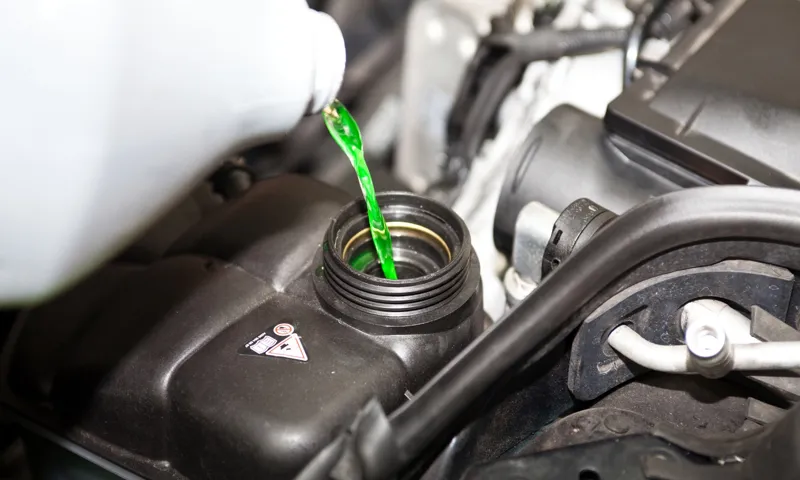Are you wondering how often you should do a coolant flush for your car? Well, let me tell you, it’s an essential maintenance task that you shouldn’t neglect. Just like how we need regular check-ups to stay healthy, our vehicles also require regular maintenance to keep running smoothly. And one crucial aspect of this maintenance is flushing out the old coolant and replacing it with fresh coolant.
Coolant, also known as antifreeze, plays a vital role in keeping your engine cool and preventing it from overheating. Over time, however, the coolant can become contaminated with dirt, debris, and other particles, which can reduce its effectiveness. That’s why periodic coolant flushes are necessary to remove these impurities and ensure optimal engine performance.
So, how often should you do a coolant flush? Well, there’s no one-size-fits-all answer to this question. The frequency of coolant flushes depends on various factors such as the type of coolant used, the climate you live in, and the driving conditions. As a general rule of thumb, it’s recommended to flush the coolant every two to five years or at around 30,000 to 50,000 miles.
However, it’s always best to consult your vehicle’s owner manual or consult with a professional mechanic to determine the specific interval for your car. Think of a coolant flush as a refreshing spa treatment for your car’s engine. Just like how a spa treatment rejuvenates our bodies and leaves us feeling revitalized, a coolant flush can do the same for your car’s engine.
By flushing out the old coolant and replacing it with fresh coolant, you’re giving your engine a much-needed cleanse, removing any impurities that may have accumulated over time. In conclusion, a coolant flush is an essential maintenance task that you should not overlook. Regularly flushing the coolant in your car can help ensure optimal engine performance and prevent overheating.
While the specific interval may vary depending on various factors, it’s generally recommended to do a coolant flush every two to five years or at around 30,000 to 50,000 miles. So, don’t forget to pamper your car’s engine with a refreshing coolant flush from time to time. It’ll thank you by running smoothly and efficiently for years to come.
Table of Contents
What is a Coolant Flush?
A coolant flush is an essential part of maintaining your vehicle’s cooling system. Over time, coolant can become contaminated with rust, debris, and other particles that can clog the system and cause overheating. Regularly flushing your coolant system helps remove these contaminants and ensures that your engine stays cool and operates efficiently.
But how often should you do a coolant flush? Well, the general recommendation is to have a coolant flush every 30,000 to 50,000 miles, or every two to five years. However, it’s important to consult your vehicle’s owner’s manual or check with a trusted mechanic to determine the specific interval for your car. Different vehicles may have different requirements, so it’s always best to follow the manufacturer’s recommendations.
Remember, a coolant flush is a small investment that can potentially save you from costly repairs down the road. So don’t neglect this important maintenance task and keep your engine running smoothly.
Definition
coolant flush A coolant flush is a maintenance procedure that involves removing the old coolant from a vehicle’s cooling system and replacing it with fresh coolant. The cooling system is an essential part of a vehicle, as it helps to regulate the engine’s temperature and prevent it from overheating. Over time, the coolant can become contaminated with dirt, debris, and rust particles, which can affect its ability to properly cool the engine.
A coolant flush helps to remove these impurities and ensures that the cooling system is working efficiently. It is recommended to have a coolant flush performed every 30,000 to 50,000 miles or as specified by the vehicle manufacturer. By regularly performing a coolant flush, you can help maintain the performance and longevity of your vehicle’s engine.

Purpose
coolant flush.
Signs That You Need a Coolant Flush
Wondering how often to do a coolant flush on your vehicle? Well, there are a few signs that can indicate it’s time for this important maintenance task. One sign is if you notice the temperature gauge on your dashboard consistently reading higher than normal. This could be a sign that your coolant is not effectively cooling the engine, and a flush may be needed.
Another sign is if you notice a sweet smell coming from your engine or if you see a puddle of bright green liquid under your car. These could be indications of a coolant leak, which can lead to overheating and engine damage if not addressed promptly. Additionally, if it’s been several years since your last coolant flush, it’s a good idea to have it done as part of regular maintenance.
Coolant can break down over time, losing its effectiveness at preventing corrosion and maintaining proper engine temperature. So, to keep your engine running smoothly and avoid costly repairs, it’s important to stay on top of coolant flushes.
Coolant is old or discolored
“coolant flush” Do you remember the last time you had a coolant flush for your car? If not, it might be time to consider getting one. One of the signs that you need a coolant flush is if you notice that your coolant is old or discolored. Coolant, also known as antifreeze, plays a crucial role in regulating the temperature of your engine.
Over time, it can become contaminated with dirt, rust, and debris, which can hinder its ability to effectively cool your engine. If you look under the hood and see that your coolant is no longer the vibrant color it used to be, it’s a clear indication that it’s time for a coolant flush. By flushing out the old coolant and replacing it with fresh coolant, you can ensure that your engine stays cool and runs smoothly, preventing any potential damage.
So, if you notice that your coolant is looking a little worse for wear, don’t wait – schedule a coolant flush to keep your engine in tiptop shape.
Engine is overheating
“coolant flush” The engine is the heart of your vehicle, and just like our bodies need to stay cool to function properly, so does your engine. One telltale sign that your engine is overheating is when you start to see smoke billowing out from under the hood. But there are other signs that may indicate your engine is in need of a coolant flush.
If you notice that your temperature gauge is consistently higher than normal or if your engine starts to make strange noises, it’s time to take action. Neglecting these warning signs can lead to serious damage and costly repairs down the road. So, what exactly is a coolant flush? Think of it as a detox for your engine.
Over time, the coolant in your radiator can become contaminated with dirt, rust, and other debris. A coolant flush involves draining the old coolant and replacing it with fresh, clean coolant. This helps ensure that your engine stays cool and runs smoothly.
It’s like giving your engine a refreshing drink of water on a hot day. So, if you’re experiencing any of these signs, don’t ignore them. Give your engine the care it deserves with a coolant flush.
Coolant levels are consistently low
coolant flush, low coolant levels
Frequency of Coolant Flush
When it comes to maintaining your vehicle’s cooling system, one important task is to periodically flush and replace the coolant. But how often should you actually do a coolant flush? Well, it depends on several factors. One important factor is the manufacturer’s recommendation.
Some manufacturers may suggest a coolant flush every 30,000 miles, while others may recommend every 60,000 or even 100,000 miles. It’s also important to consider the type of coolant you’re using. Traditional green coolant may need to be replaced more often, while newer extended-life coolant may last longer.
Finally, consider the conditions in which you drive your vehicle. If you frequently drive in extreme temperatures or do a lot of towing, you may need to flush the coolant more frequently. As always, it’s best to consult your vehicle’s owner’s manual or speak with a trusted mechanic to determine the optimal frequency for your specific vehicle.
Manufacturer’s recommendation
Frequency of coolant flush When it comes to maintaining your vehicle, one important aspect to consider is the coolant flush. But how often should you actually flush your coolant? Well, the answer to that question can vary depending on the manufacturer’s recommendation for your specific vehicle. Each manufacturer may have different guidelines for when a coolant flush is necessary, so it’s essential to consult your owner’s manual or reach out to the manufacturer directly for clarification.
This is because the frequency of coolant flushes can depend on factors such as the type of coolant used, the age of the vehicle, and the driving conditions. Some manufacturers may recommend a coolant flush every 30,000 miles, while others may advise every 50,000 miles or even longer. By following the manufacturer’s recommendation, you can ensure that your coolant system remains in good condition and that your engine stays cool, preventing any potential overheating issues.
Typical intervals
Typical Intervals When it comes to maintaining your car, there are certain tasks that need to be done on a regular basis. One of these tasks is flushing the coolant. But how often should this be done? The frequency of coolant flushes can vary depending on a few factors.
Most car manufacturers recommend having the coolant flushed every 30,000 to 60,000 miles, or every 2 to 3 years. However, it’s important to note that this is just a general guideline and the actual interval may vary depending on the make and model of your vehicle, as well as your driving habits and the conditions you typically drive in. For example, if you frequently drive in extreme temperatures or through dusty or sandy environments, you may need to have the coolant flushed more frequently.
On the other hand, if you primarily drive in moderate temperatures and conditions, you may be able to go longer between flushes. It’s always a good idea to consult your car’s owner manual or speak to a professional mechanic to determine the best interval for your specific vehicle.
Factors that may affect frequency
frequency of coolant flush
How to Perform a Coolant Flush
One important maintenance task for your vehicle is performing a coolant flush. This procedure helps to prolong the life of your engine and prevent overheating. But how often should you do a coolant flush? The recommended interval for a coolant flush can vary depending on the make and model of your vehicle.
However, a general guideline is to perform a coolant flush every 24,000 to 36,000 miles or every two to three years. It’s also a good idea to check your vehicle’s owner’s manual for specific recommendations. By regularly flushing the coolant, you can remove any contaminants or debris that may have built up in the system, ensuring that your engine stays cool and running smoothly.
So, don’t forget to include a coolant flush in your regular maintenance schedule to keep your vehicle in tip-top shape.
Gather necessary materials
In order to perform a coolant flush on your vehicle, you will need to gather a few essential materials. First and foremost, you will need the appropriate coolant for your vehicle. This can vary depending on the make and model, so be sure to consult your owner’s manual or a trusted automotive professional to determine the correct type of coolant to use.
Additionally, you will need a coolant flush kit, which typically includes a flush and cleaner solution. This kit is important as it will help remove any built-up debris or contaminants in your cooling system. You will also need a drain pan or bucket to catch the old coolant as it is drained from the system.
Lastly, it is a good idea to have some basic tools on hand, such as pliers or wrenches, to help remove any necessary components during the flush process. By ensuring you have all of these materials ready before beginning the coolant flush, you will be well-prepared to complete the task smoothly and efficiently.
Raise the vehicle and locate the drain plug
Performing a coolant flush is an essential maintenance task that helps to keep your vehicle running efficiently. One important step in this process is raising the vehicle and locating the drain plug. This allows you to effectively drain out all of the old coolant and prepare the system for fresh coolant.
When raising the vehicle, it’s important to use a car jack or ramps that are designed for this purpose. Safety should always be the top priority, so make sure the vehicle is stable and secure before crawling underneath. Once the vehicle is lifted, you can locate the drain plug, which is typically found on the bottom of the radiator.
It may be covered by a protective shield, so you may need to remove it to access the plug. Once the plug is located, use a wrench to loosen it and allow the old coolant to drain into a collection container. This step is crucial because it removes any sediment or debris that may have accumulated in the coolant system.
Once the coolant has completely drained, you can safely remove the drain plug and move on to the next step in the coolant flush process. Remember to dispose of the old coolant properly, as it is harmful to humans, animals, and the environment. By following these steps and regularly performing a coolant flush, you can ensure that your vehicle’s cooling system remains in optimal condition.
Drain the old coolant
coolant flush, drain coolant
Flush the system with clean water
coolant flush, clean water A coolant flush is an important maintenance task for your vehicle, as it helps to keep the engine running smoothly and prevents overheating. One of the key steps in performing a coolant flush is to flush the system with clean water. This removes any contaminants and debris that may have built up in the coolant over time.
To do this, you will need to drain the old coolant from the radiator and then refill it with clean water. It’s important to make sure that the water is clean and free of any impurities, as these can potentially damage the engine. Once the system has been flushed with clean water, you can then proceed with adding new coolant to the radiator.
This is a crucial step in maintaining the health of your engine and ensuring that it operates at its optimal temperature. So don’t forget to flush the system with clean water during your coolant flush!
Refill the system with fresh coolant
coolant flush, fresh coolant, refill the system
Conclusion
In the perplexing world of car maintenance, one of the burning questions that often leaves us scratching our heads is how often we should do a coolant flush. This vital procedure may not be as glamorous or exciting as tire rotations or oil changes, but it is just as important for the long-term health and performance of your vehicle. So, let’s dive into the delectable depths of the coolant flush conundrum and find ourselves a satisfying conclusion.
Just like a clogged drain, your car’s cooling system can become congested with debris, rust, and other unsightly gunk over time. This can lead to overheating, engine damage, and a whole lot of trouble James Bond would not hesitate to avoid. Imagine your cooling system as a refreshing river, flowing smoothly and effortlessly, whisking away the excess heat from your engine like a cool breeze on a scorching summer day.
But alas, as the miles pile on and the seasons change, that once pristine river slowly transforms into a murky swamp, blocking the flow and impeding the vital task of regulating your engine’s temperature. So, how often should you flush this swampy mess, you ask? Well, it ultimately depends on a variety of factors, including the make and model of your vehicle, your driving habits, and even the weather conditions in your neck of the woods. As a general rule of thumb, most car experts recommend flushing your coolant every 30,000 miles or every five years, whichever comes first.
However, if you’re particularly adventurous in your driving endeavors or live in an area with extreme temperatures, it might be wise to do it more frequently, just like changing your socks after hiking through a muddy field. In the end, taking the time to flush your coolant regularly is a small but mighty investment in the longevity and efficiency of your vehicle. It’s like giving your car a refreshing spa day, complete with cucumber slices for the radiator and a hot stone massage for the hoses.
So, my fellow automotive aficionados, let’s embrace the power of the coolant flush and honor it as the unsung hero of car maintenance. Just remember, neglecting this essential task is like ignoring a Tinder match hoping they’ll magically disappear – it’ll only lead to a hot mess and a lot of regret. Now, be the hero your engine deserves, and show that cooling system some love.
Your car will thank you with countless miles of smooth sailing and fewer meltdowns than a toddler at an ice cream shop. Go forth, my friends, and keep your cool – both on and off the road!”
Importance of regular coolant flushes
coolant flush Regular coolant flushes are vital for maintaining the health and longevity of your vehicle’s cooling system. Over time, coolant can become contaminated with rust, dirt, and other impurities that can hinder its ability to regulate the engine’s temperature. When coolant is not flushed regularly, these impurities can build up and cause blockages in the radiator, thermostat, and other cooling system components.
This can lead to overheating issues, engine damage, and costly repairs. Performing a coolant flush involves draining the old coolant from the system and replacing it with fresh coolant. This process helps to remove any sediment or debris that may have accumulated in the system, ensuring that the coolant can effectively absorb and dissipate heat.
By keeping your coolant system clean and functioning properly, you can prevent overheating and extend the life of your engine. So, don’t overlook the importance of regular coolant flushes – they can save you time, money, and stress in the long run.
Following manufacturer’s recommendations
coolant flush, following manufacturer’s recommendations, car maintenance
Consulting a professional if unsure
coolant flush, consulting a professional, performing a coolant flush If you are unsure about how to perform a coolant flush on your vehicle, it is always a good idea to consult a professional. While performing a coolant flush may seem like a simple task, there are certain steps and precautions that need to be taken to ensure that it is done correctly. A professional mechanic will have the knowledge and expertise to properly flush the coolant system and prevent any damage to your vehicle.
They will also be able to recommend the appropriate type and amount of coolant to use for your specific vehicle. So, if you are unsure about how to perform a coolant flush, don’t hesitate to reach out to a professional for assistance. It is better to be safe than sorry when it comes to the maintenance of your vehicle.
FAQs
How often should I do a coolant flush?
It is generally recommended to do a coolant flush every 2-3 years or every 30,000-50,000 miles, but it can vary depending on the specific vehicle and coolant type.
What are the signs that indicate the need for a coolant flush?
Signs that indicate the need for a coolant flush include overheating, coolant leaks, a sweet smell in the cabin, and discolored or contaminated coolant.
Can I do a coolant flush myself or should I take it to a professional?
While a coolant flush can be done as a DIY project, it is recommended to take it to a professional to ensure proper flushing and disposal of the old coolant.
Is it necessary to use a specific type of coolant for a coolant flush?
It is important to use the correct coolant recommended by the vehicle manufacturer for your specific make and model. Using the wrong coolant can cause damage to the cooling system.
How long does a coolant flush typically take?
A coolant flush can take approximately 30 minutes to 1 hour, depending on the vehicle and the condition of the coolant.
What are the benefits of regular coolant flushes?
Regular coolant flushes help remove contaminants, prevent overheating, minimize corrosion and rust, and extend the lifespan of the cooling system components.
Can a coolant flush improve engine performance?
Yes, a coolant flush can help improve engine performance by ensuring proper cooling and preventing overheating, which can negatively impact engine performance.



